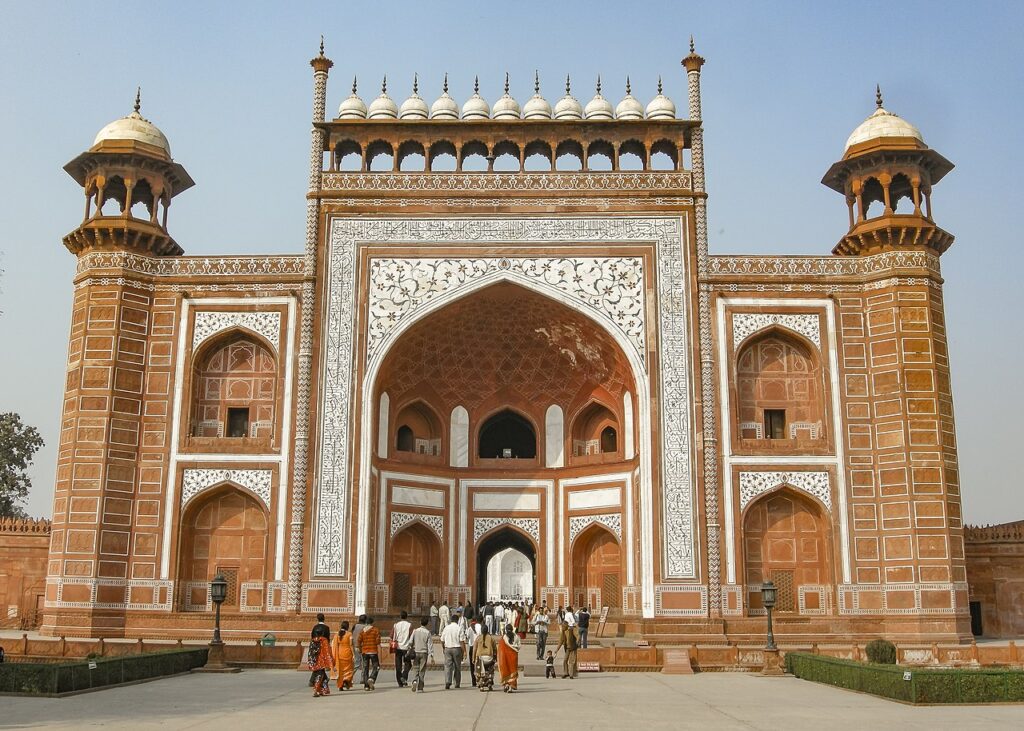
The Taj Mahal, located in Agra, India, is one of the most iconic and recognizable buildings in the world. Built in the 17th century by the Mughal Emperor Shah Jahan as a mausoleum for his beloved wife Mumtaz Mahal, the Taj Mahal is a masterpiece of architecture, art, and engineering that continues to capture the imagination and inspire awe in visitors from around the world.
The Mughals
The Mughal Empire was a powerful empire that ruled over a large part of the Indian subcontinent from the early 16th to the mid-19th century. It was founded by Babur, a Turkic-Mongol prince who established his rule in India in 1526 after defeating the Sultan of Delhi in the Battle of Panipat. Under Babur’s successors, the Mughal Empire grew in size and power, becoming one of the most important empires in world history. The empire was known for its rich cultural heritage, which included art, architecture, literature, and music.
During the reign of Emperor Akbar, the empire reached its zenith, with a strong centralized government, a prosperous economy, and religious tolerance. Akbar was known for his policy of Sulh-i-kul, which aimed to promote harmony and peaceful coexistence between people of different religions.The Mughal Empire continued to flourish under the rule of Jahangir and Shah Jahan, who were known for their patronage of the arts and their construction of magnificent buildings, such as the Taj Mahal.
However, by the mid-18th century, the Mughal Empire began to decline due to a combination of factors, including weak leadership, internal conflict, and external pressures from European powers. The empire was eventually dissolved by the British East India Company in 1858, marking the end of a remarkable chapter in Indian history.
History and Architecture
Construction of the Taj Mahal began in 1632 and took over 20 years to complete. The mausoleum was designed by a team of architects and artisans from India, Persia, and the Ottoman Empire, and is considered a masterpiece of Mughal architecture, which combines elements of Persian, Indian, and Islamic design.
The mausoleum is made of white marble and features intricate carvings and inlaid gemstones that create stunning patterns and designs. The main structure is surrounded by four minarets, which serve both as a decorative element and as a means of support for the main dome.
The interior of the Taj Mahal is equally stunning, with elaborate carvings and decorative features throughout. The central chamber contains the tombs of Shah Jahan and Mumtaz Mahal, which are surrounded by delicate marble screens and inscriptions from the Quran.

Symbolism and Meaning
The Taj Mahal is not only a stunning work of art and architecture, but it also holds deep symbolic and cultural significance. The mausoleum was built as a tribute to the love between Shah Jahan and Mumtaz Mahal, who was his third wife and his favorite. Mumtaz Mahal died during childbirth, and Shah Jahan was grief-stricken. He commissioned the Taj Mahal as a way to honor her memory and express his eternal love for her.
The building’s design and decoration also have deep symbolic meaning. The white marble is meant to represent purity, while the intricate carvings and inlaid gemstones are meant to symbolize the beauty and richness of life. The use of symmetry and balance throughout the design is also significant, as it reflects the concept of the perfect order and harmony of the universe.
Visiting the Taj Mahal
Today, the Taj Mahal is one of the most popular tourist destinations in India and attracts millions of visitors each year. Visitors can enter the mausoleum and see the tombs of Shah Jahan and Mumtaz Mahal, as well as explore the surrounding gardens and grounds.
To preserve the beauty and integrity of the building, certain restrictions are in place for visitors. For example, visitors are required to remove their shoes before entering the mausoleum to prevent damage to the marble floors. Photography is also restricted in certain areas to prevent damage to the delicate carvings and inlaid gemstones.
Despite these restrictions, visiting the Taj Mahal is an unforgettable experience. The beauty and grandeur of the building are awe-inspiring, and the deep symbolism and cultural significance make it a truly meaningful and unforgettable destination.
If you’re planning a trip to India, visiting the Taj Mahal is an absolute must. As one of the world’s most iconic and beloved buildings, the Taj Mahal offers visitors a unique and unforgettable experience that’s sure to leave a lasting impression. Here’s a quick tourist guide to help you make the most of your visit:
Getting There
The Taj Mahal is located in the city of Agra, which is about a three-hour drive from the Indian capital of New Delhi. There are several options for getting to Agra, including by train, bus, or private car. If you’re short on time or want to avoid the hassle of arranging transportation, you can also book a day tour from Delhi that includes transportation, admission, and a guide.
Admission and Tickets
To enter the Taj Mahal, you’ll need to purchase a ticket, which can be done online or in person. Admission fees vary depending on whether you’re a foreigner or a local, with foreign visitors paying a higher fee. It’s also important to note that there are restrictions on the types of items you can bring into the Taj Mahal, including bags, cameras, and food.

Exploring the Taj Mahal
Once you enter the Taj Mahal, you’ll be struck by the sheer beauty and grandeur of the building. Be sure to take your time and explore the various areas of the mausoleum, including the central chamber where the tombs of Shah Jahan and Mumtaz Mahal are located. You’ll also want to take in the intricate carvings and inlaid gemstones that decorate the building’s walls and floors.
If you’re interested in learning more about the history and symbolism of the Taj Mahal, consider hiring a guide. There are many licensed guides available at the entrance of the Taj Mahal who can provide insight into the building’s design, construction, and cultural significance.
Do’s and Don’ts of Visiting the Taj Mahal
To make the most of your visit to the Taj Mahal, here are a few tips:
- Arrive early: The Taj Mahal can get crowded, especially during peak tourist season. Arriving early in the morning will give you a chance to beat the crowds and enjoy the building’s beauty in peace.
- Be prepared for security: The Taj Mahal is a high-security site, so be prepared to go through metal detectors and have your bags searched before entering.
- Respect the rules: To preserve the beauty and integrity of the Taj Mahal, certain rules are in place for visitors. Be sure to follow these rules, including removing your shoes before entering the mausoleum, to avoid damaging the building’s delicate marble floors.
If you want to have a deeper look into the Do’s and Don’ts of visiting the Taj Mahal, check this article out which details a strategy which will make sure that you can enjoy a safe and fulfilling experience and see the Taj Mahal in its full beauty.
Visiting the Taj Mahal is a once-in-a-lifetime experience that’s sure to leave a lasting impression. By following these tips and taking your time to explore and appreciate the building’s beauty, you’ll be able to make the most of your visit and create unforgettable memories.
To bring this to an end, visiting the The Taj Mahal is a testament to the power of love and the enduring legacy of the Mughal Empire. Its stunning architecture, intricate decoration, and deep symbolism continue to inspire and captivate visitors from around the world, making it one of the most iconic and beloved buildings in the world. For anyone interested in art, architecture, history, or culture, a visit to the Taj Mahal is an absolute must.


No Comments